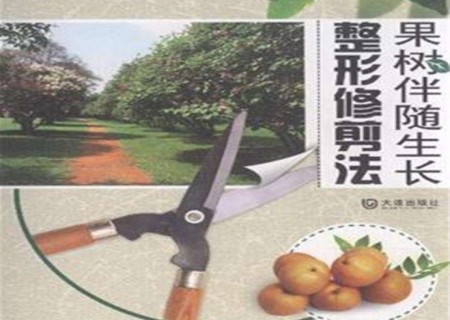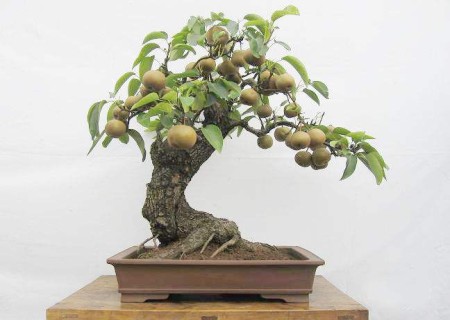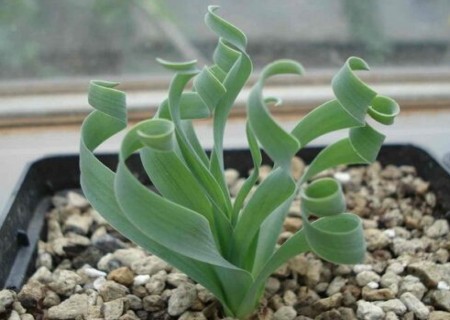Principles of standard shaping and pruning of bonsai for fruit trees
Bonsai fruit trees have ornamental value all the year round, with exquisite flowers in spring, luxuriant branches and leaves in summer, numerous fruits in autumn, vigorous and vigorous in winter, and full of interest in life. China is rich in fruit tree resources. In the mountains, all kinds of wild fruit trees and their rootstock resources can be used, and local bonsai with local characteristics can also be developed according to local conditions. There are many kinds of fruit trees, which can be used locally and are convenient for production and management. The investment is small, and ordinary families can cultivate them.

According to the characteristics of fruit tree species and varieties, the bonsai of fruit trees can be shaped into a variety of shapes, such as natural round head shape, tower shape, double-branch deer horn shape, three-branch cup shape, weeping willow shape, dragon curve shape and so on. In shaping the shape of the tree, it should not only be beneficial to the fruit of potted fruit trees, but also have ornamental value. Commonly used measures to promote flower dwarfing, shaping and pruning are: wiping buds, coring, taking branches, twigs, ring cutting, retraction, pulling branches and so on. We can also enhance the light by opening the branch angle and thinning the long branches, dense branches, invalid branches and other methods to sort out the ideal shape of the bonsai of fruit trees.
After the grafting survives and grows normally, in order to enhance the aging of bonsai, a grafting knife can be used to carve several curves on the tree trunk. In the growing season, iron wire can be wrapped around the branches of fruit trees to fix the desired tree shape. In addition, drugs can also be used to dwarf trees, such as spraying plant growth retarders (such as paclobutrazol, B9, dwarf, etc.) on the leaves for 2 or 3 times during the growing period of bonsai of fruit trees (summer), which can make the branches stout, internodes shorter and plants dwarf. In addition, the amount of bonsai fruit should be controlled moderately.
When the number of flower buds of bonsai is too large, fruit thinning should be carried out during the bud period or after the physiological fruit drop period; if the number of flower buds is small, more buds can be left appropriately and artificial pollination should be carried out to increase the amount of fruit.
Standard pruning principles for bonsai of fruit trees:
1. The technique of shaping and pruning should be beneficial to the formation of tree crown. Dwarfing and dense tree planting also requires a certain number of growing branches in a short period of time to ensure the fruiting volume of early high yield.
2. The technology of shaping and pruning should promote the conversion and accumulation of nutrients, which is beneficial to the formation of flower buds and achieve the goal of early fruiting, early high yield and stable yield.
3. The technique of shaping and pruning should be beneficial to lighting. Dense planting garden is easy to cause canopy closure, so it is necessary to make dense planting trees ventilated and transparent by shaping and pruning. Therefore, different planting density should adopt different shaping methods, through shaping and pruning to achieve the purpose of dense branches and good light.
4. dense tree planting should control the size of the tree and reduce the height of the tree through shaping and pruning. The polarity of the pear tree is strong, and the tree is easy to grow upward because of the small row spacing. Trees should be dwarfed by shaping and pruning.
Time: 2019-06-09 Click:
- Prev

Pruning principle of bonsai of fruit trees
When there are too many bonsai branches of fruit trees, it is easy to cause scattered nutrients, lack of internal light, poor fruit quality and so on. Therefore, cross branches, overlapping branches, disease and insect branches and overgrown branches should be cut off before sprouting in spring, which is called basic pruning. During the summer fruit growing period
- Next

Sowing technique of broad-leaf spring grass
The sowing of spring grass should be carried out in autumn, and after sowing, it should be covered with thin soil and covered with glass, so as to keep the soil and air moist and have a high emergence rate. It should be pointed out that due to the scarcity of seed resources of Rabdosia angustifolia, some unscrupulous merchants confuse the real with the fake.
Related
- Fuxing push coffee new agricultural production and marketing class: lack of small-scale processing plants
- Jujube rice field leisure farm deep ploughing Yilan for five years to create a space for organic food and play
- Nongyu Farm-A trial of organic papaya for brave women with advanced technology
- Four points for attention in the prevention and control of diseases and insect pests of edible fungi
- How to add nutrient solution to Edible Fungi
- Is there any good way to control edible fungus mites?
- Open Inoculation Technology of Edible Fungi
- Is there any clever way to use fertilizer for edible fungus in winter?
- What agents are used to kill the pathogens of edible fungi in the mushroom shed?
- Rapid drying of Edible Fungi

